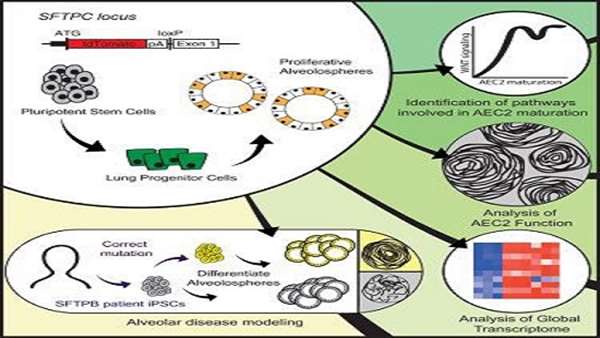Differentiation of Human Pluripotent Stem Cells into Functional Lung Alveolar Epithelial Cells
Lung alveoli, which are unique to air-breathing organisms, have been challenging to generate from pluripotent stem cells (PSCs) in part because there are limited model systems available to provide the necessary developmental roadmaps for in vitro differentiation
Highlights
- •SFTPC reporter PSC lines allow isolation of putative PSC-derived AEC2s (iAEC2s)
- •iAEC2s extensively self-renew, growing as proliferative alveolospheres
- •Lamellar bodies present in iAEC2s are able to functionally process surfactant
- •Temporal regulation of Wnt activity promotes PSC-derived AEC2 maturation
Summary
Lung alveoli, which are unique to air-breathing organisms, have been challenging to generate from pluripotent stem cells (PSCs) in part because there are limited model systems available to provide the necessary developmental roadmaps for in vitro differentiation. Here we report the generation of alveolar epithelial type 2 cells (AEC2s), the facultative progenitors of lung alveoli, from human PSCs. Using multicolored fluorescent reporter lines, we track and purify human SFTPC+ alveolar progenitors as they emerge from endodermal precursors in response to stimulation of Wnt and FGF signaling. Purified PSC-derived SFTPC+ cells form monolayered epithelial “alveolospheres” in 3D cultures without the need for mesenchymal support, exhibit self-renewal capacity, and display additional AEC2 functional capacities. Footprint-free CRISPR-based gene correction of PSCs derived from patients carrying a homozygous surfactant mutation (SFTPB121ins2) restores surfactant processing in AEC2s. Thus, PSC-derived AEC2s provide a platform for disease modeling and future functional regeneration of the distal lung.
http://www.cell.com/cell-stem-cell/fulltext/S1934-5909(17)30332-6





ارسال به دوستان